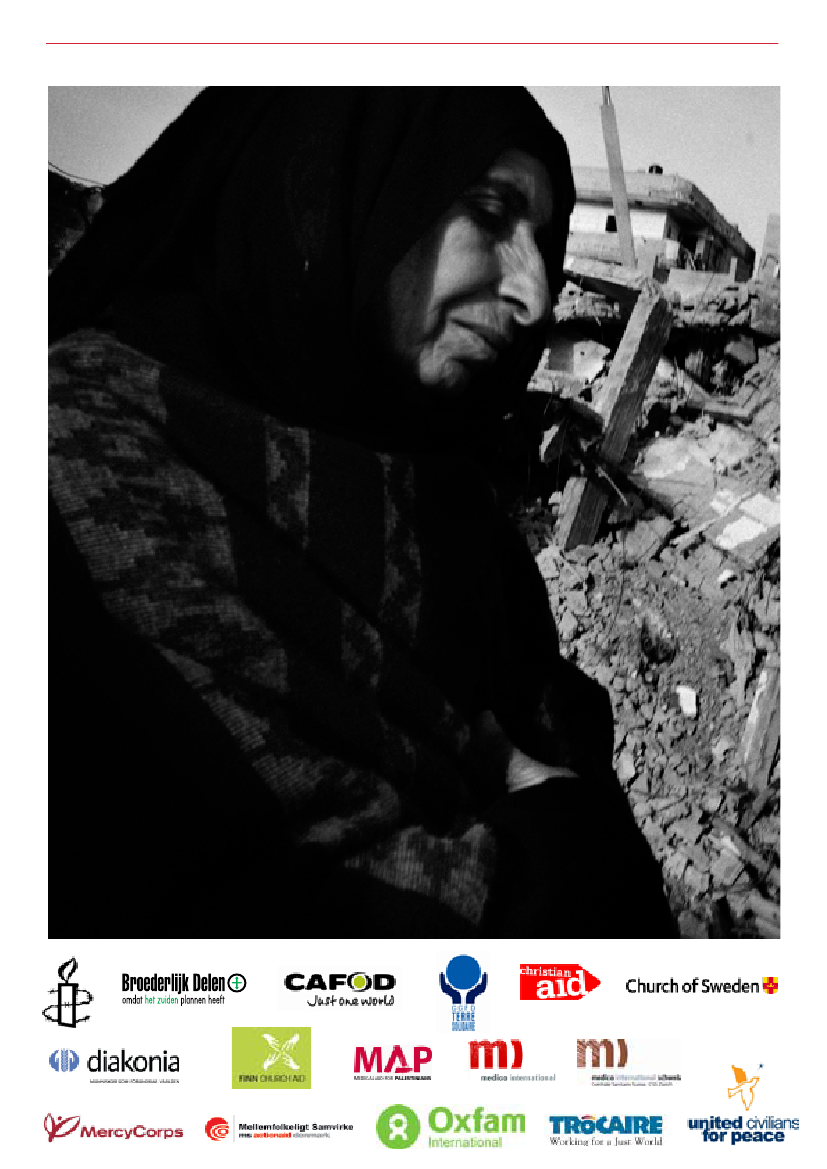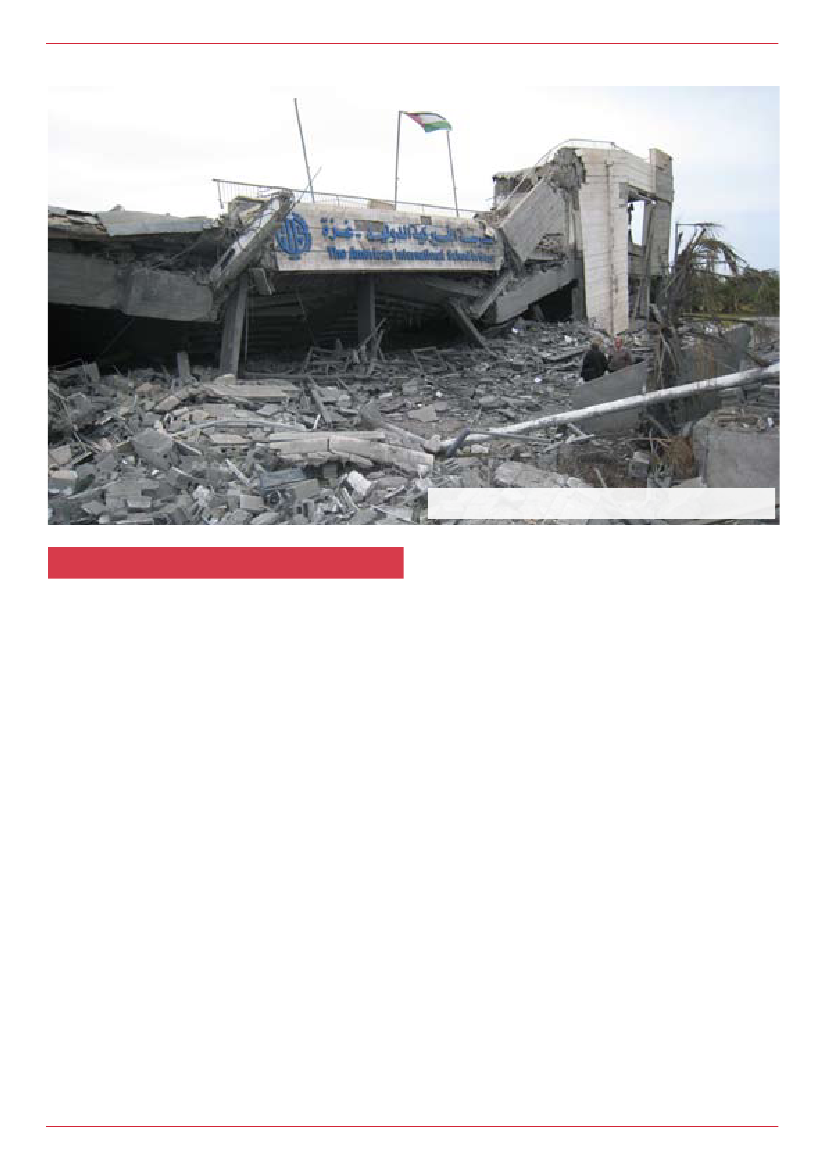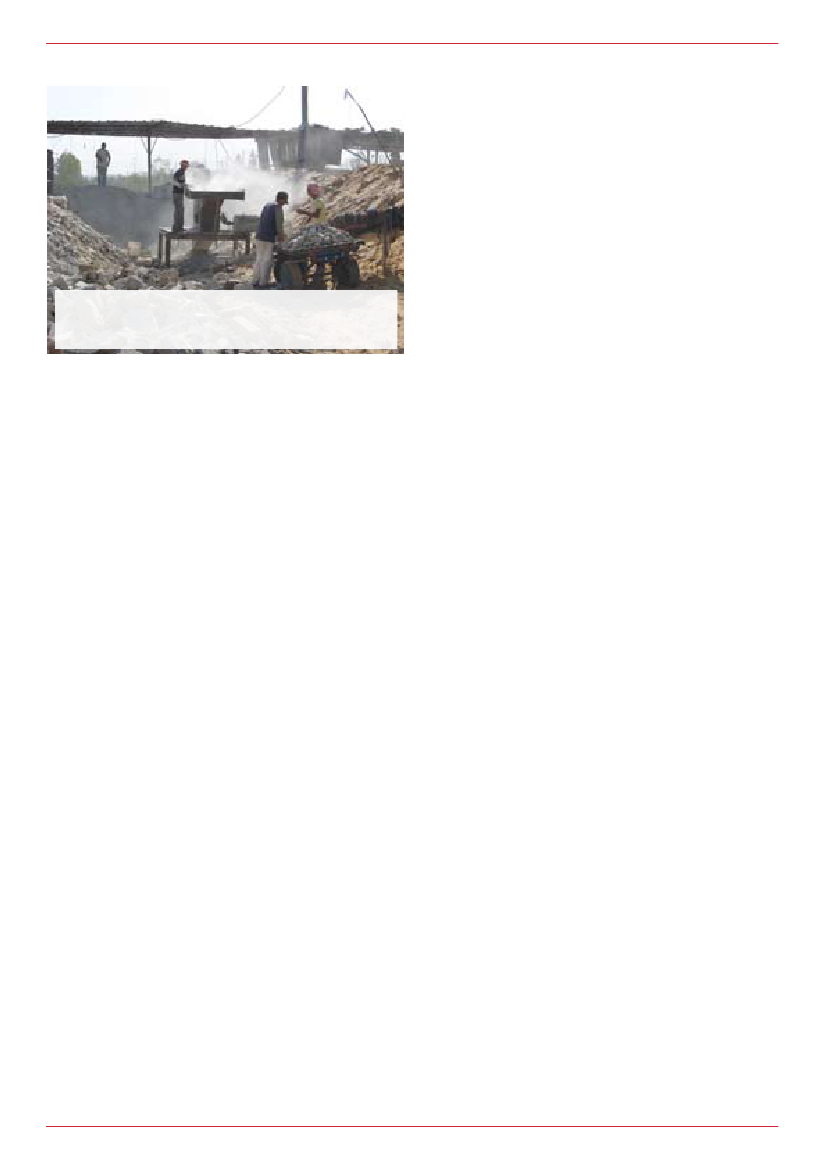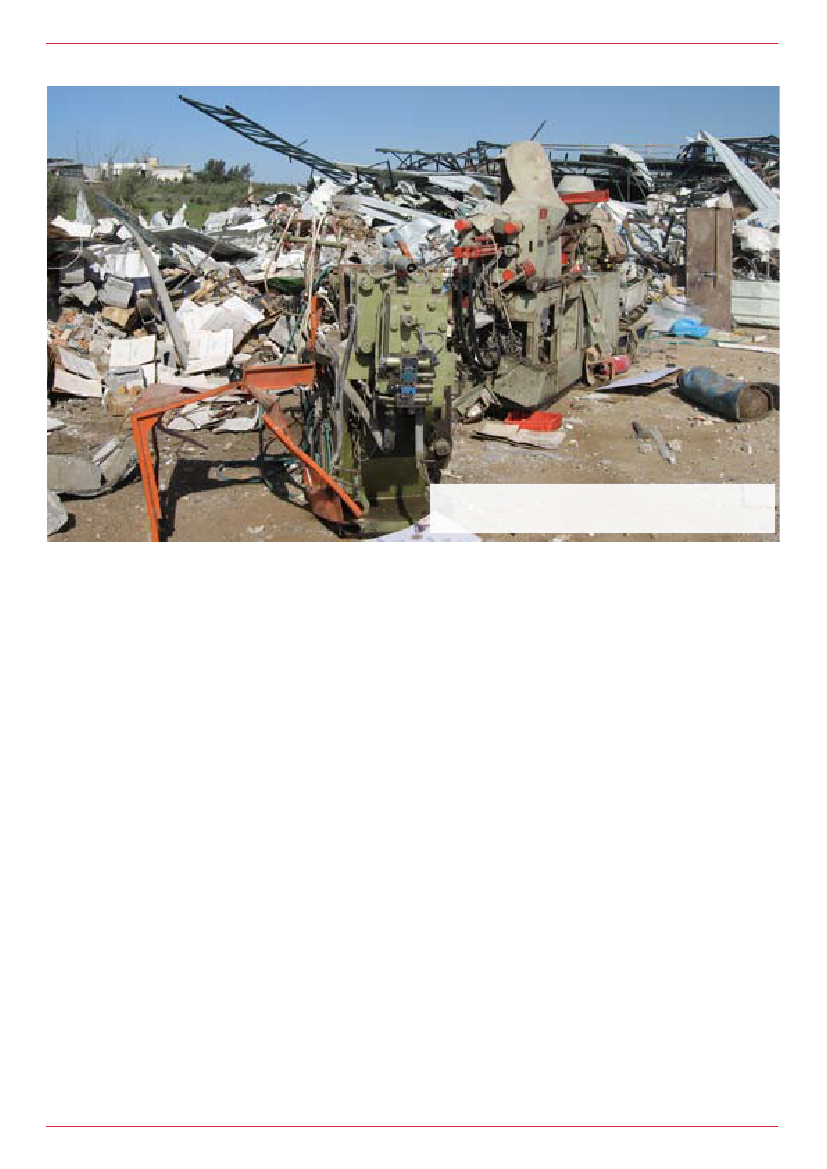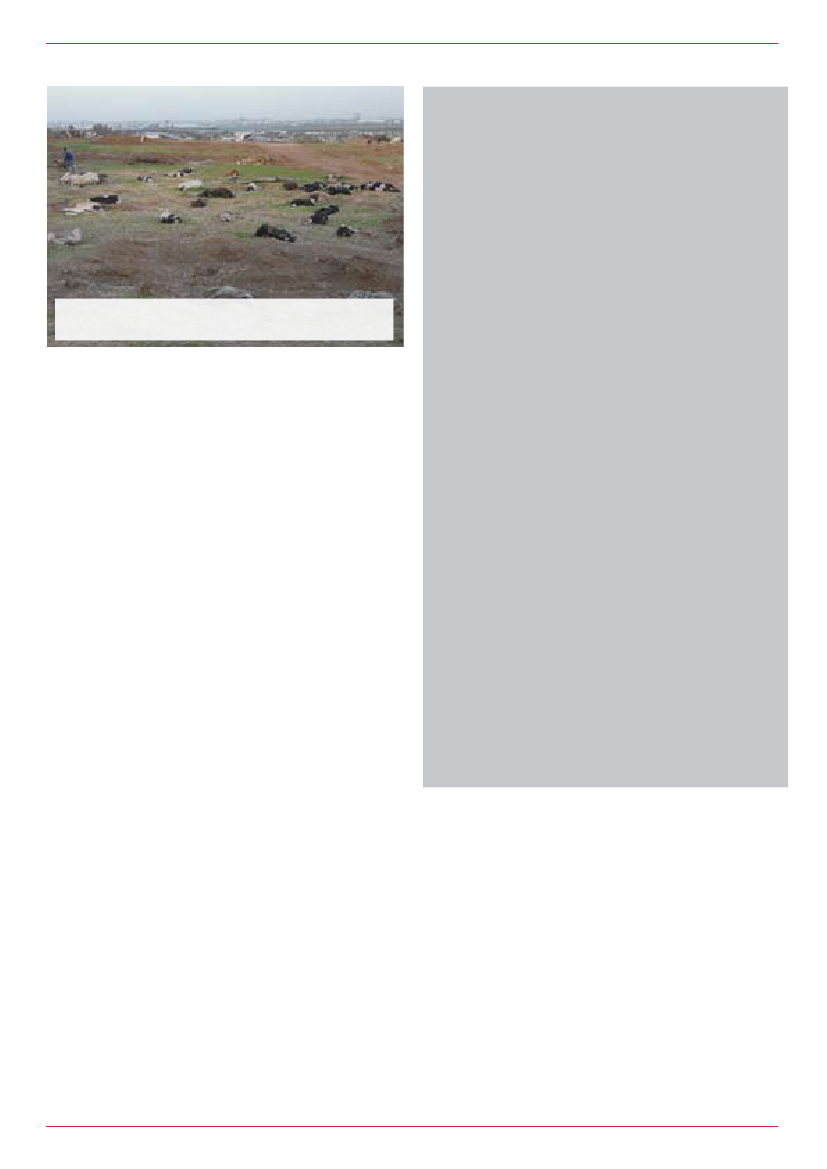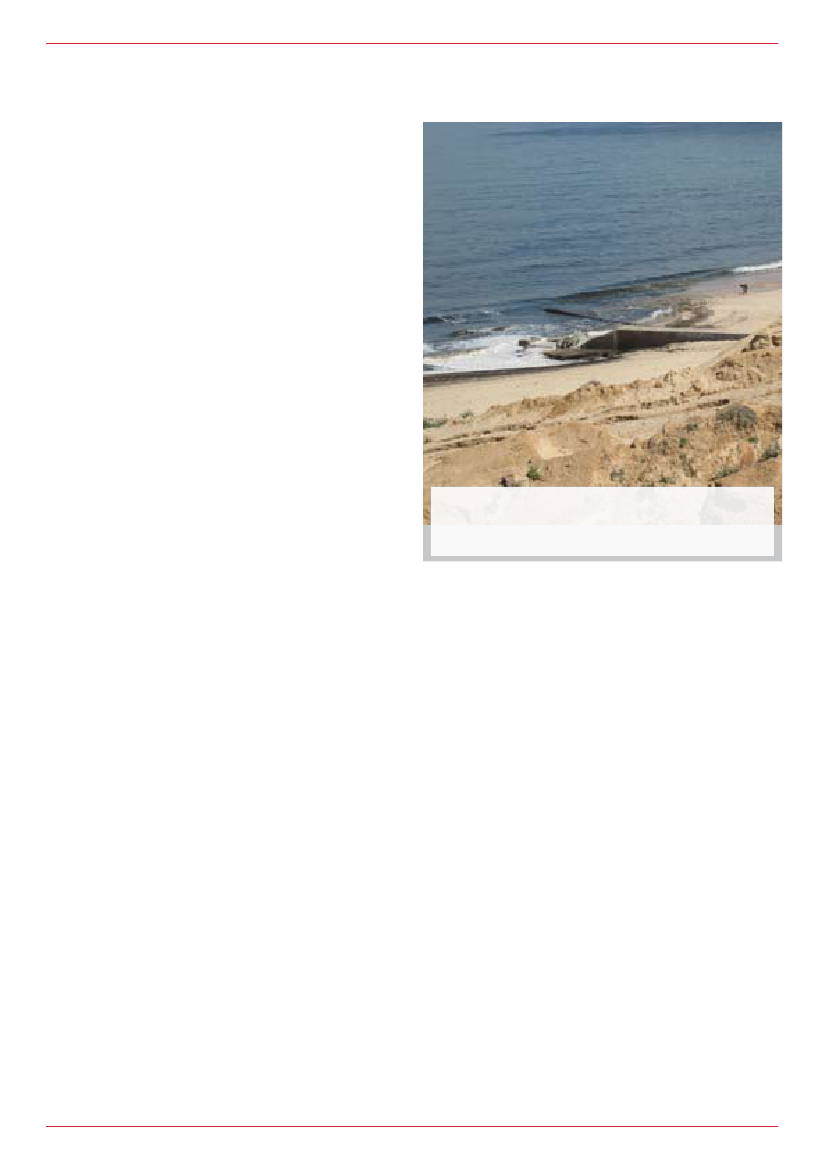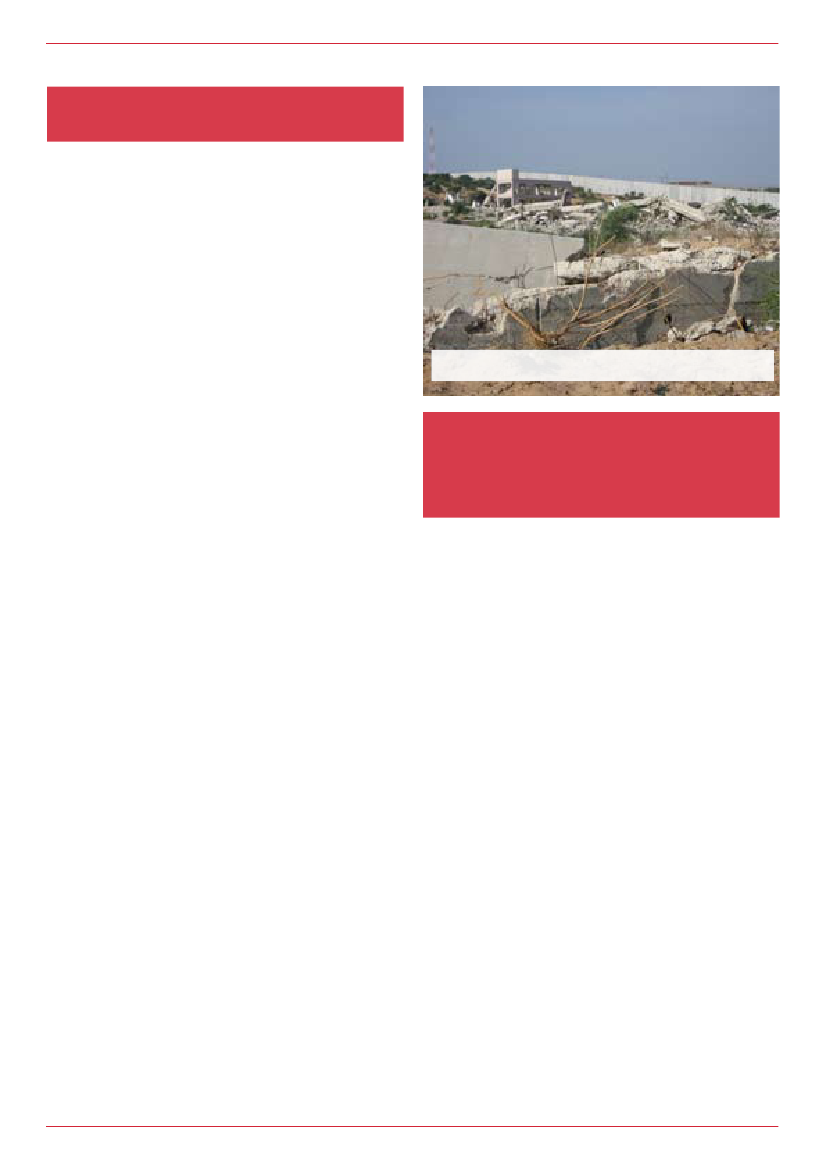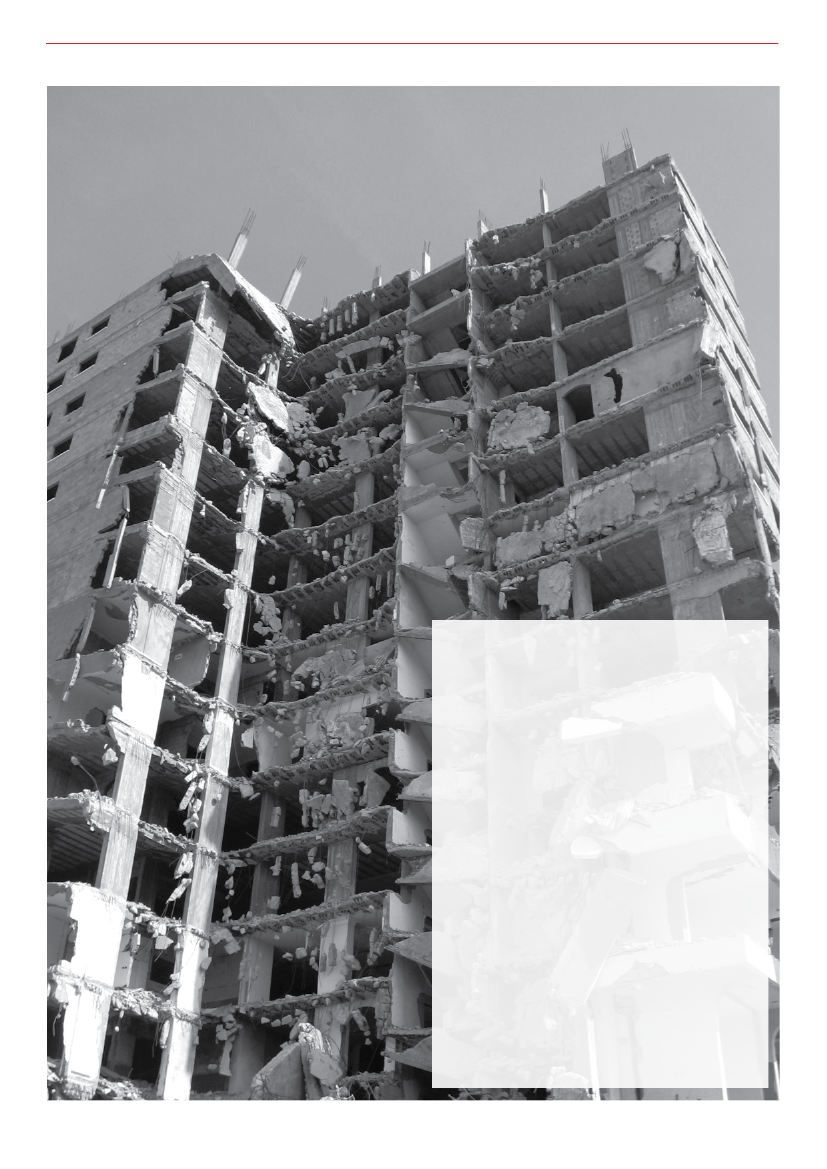Europaudvalget 2009-10
EUU Alm.del Bilag 173
Offentligt
Embargo:Not for publication or quotation before 00.01 GMT Tuesday 22 December 2009
Failing gaza:no rebuilding,no recovery,no more excusesa report one year after Operation Cast lead
1
Failing gaza:No rebuilding, no recovery, no more excuses
Embargo:Not for publication or quotation before 00.01 GMT Tuesday 22 December 2009
This report is published by:Amnesty International UKBroederlijk Delen (Belgium)CAFOD (UK)CCFD Terre Solidaire (France)Christian Aid (UK and Ireland)Church of SwedenDiakonia (Sweden)Finn Church Aid (Finland)Medical Aid for Palestiniansmedico international (Germany)medico international schweiz (Switzerland)Mercy CorpsMS ActionAid DenmarkOxfam InternationalTrocaire (Ireland)United Civilians for Peace (a coalition of Dutchorganisations - Oxfam Novib, Cordaid, ICCO,and IKV Pax Christi)
For more information please contact:[email protected]Published December 2009Front cover picture: Kadir van LohuizenBack cover picture: Ben Jackson
1
Failing gaza:No rebuilding, no recovery, no more excuses
Embargo:Not for publication or quotation before 00.01 GMT Tuesday 22 December 2009
Table of Contents1) No more excuses.....................................................................................................3International responsibility......................................................................................4Time to rebuild.........................................................................................................42) The policy: Building blocked...................................................................................5Before and after.......................................................................................................5Construction materials............................................................................................63) The cost: No reconstruction, no recovery...............................................................7Homes.....................................................................................................................7Industry and jobs.....................................................................................................8Farming...................................................................................................................9Power....................................................................................................................10Water and sanitation.............................................................................................10Health.....................................................................................................................11Education..............................................................................................................124) Israel and the blockade.........................................................................................135) Response of the international community and particularly the European Union.13Responsibility for reconstruction..........................................................................14Responding to the blockade: many words, little action........................................14Diplomatic initiatives and plans.............................................................................156) A call to action.......................................................................................................16Recommendations to the international community..............................................16References................................................................................................................17
2
Failing gaza:No rebuilding, no recovery, no more excuses
Embargo:Not for publication or quotation before 00.01 GMT Tuesday 22 December 2009
The American International School in Gaza, January 2009, after Operation Cast Lead.� Amnesty International
1) No more excusesA year after Israel launched its Operation Cast Leadmilitary offensive on Gaza, on 27 December 2008,little of the extensive damage it caused to homes,civilian infrastructure, public services, farms andbusinesses has been repaired. As thousands offamilies still come to terms with loss or injury of theirloved ones, they are being prevented from rebuildingtheir shattered society.This is not for a lack of determination by thepeople of Gaza or of resources committed to dothe job. Indeed, over US$4 billion was pledgedin March 2009 by the international communityto assist reconstruction in Gaza and to supportthe Palestinian economy.1Gaza’s jobless peopleare only too ready to put their skills and work intorebuilding their wrecked homes or getting theshattered water, sewage and electricity systemsworking again. Crossing points into Gaza fromIsrael have been designed and tested and securityprocedures developed that could facilitate thelarge-scale entry of the materials needed forreconstruction. But little of this committed moneyhas been spent. Goods and equipment earmarkedfor rebuilding languish in storage outside Gaza. Andmuch of Gaza still lies in ruins.This is not an accident; it is a matter of policy. TheIsraeli government’s blockade, imposed in 2007after Hamas took control of Gaza (though longpreceded by regular closures and restrictions), notonly forbids most Gazans from leaving or exportinganything to the outside world, but also only permitsthe import of a narrowly-restricted number ofbasic humanitarian goods. Desperately-neededreconstruction materials are not counted amongstthese. So the civilian population and the UnitedNations and aid agencies that aim to help them areprohibited from importing materials like cement orglass for reconstruction in all but a handful of cases.Indeed, since Operation Cast Lead, only 41truckloads of construction materials for all purposeshave been permitted into Gaza.2Thousands oftruckloads are required to rebuild all the housesdestroyed. And this is to say nothing of all theremaining reconstruction desperately needed toput right damage to all the schools, hospitals, otherbuildings and water network because of previousmilitary action or serious dilapidation caused by lackof repair materials due to the blockade. The rest ofthis paper sets out other evidence of the blockade’scontinuing and devastating impact, based on theexperience of the authoring agencies and data fromthe UN.
3
Failing gaza:No rebuilding, no recovery, no more excuses
Embargo:Not for publication or quotation before 00.01 GMT Tuesday 22 December 2009
international responsibilityIsrael has the primary responsibility to end theblockade. Egypt, the Palestinian Authority andHamas must also play their role. Though the focusof this report is on the blockade, we also citeexamples of how PA-Hamas tensions, and actionsby both have created additional hardship. Thepeople of Gaza have suffered as a result of all thesegovernments, at times, failing to uphold their rights.We condemn all indiscriminate rocket attacks onIsrael from Gaza. Israel has the right and obligationto protect its citizens. The policy of blockade,punishing the entire civilian population of Gazafor the acts of a few, is a collective punishment,which is unacceptable and violates internationallaw. The blockade is also in breach of UN SecurityCouncil Resolution 1860, and of the Agreementon Movement and Access signed by Israel and thePalestinian Authority in 2005.While members of the international community – tovarying degrees – profess their disapproval of theblockade, they have failed to secure any significantprogress, including any change to the prohibitionon construction materials, let alone a commitmentto end the policy as a whole. Expressions ofdisapproval and hand-wringing by the internationalcommunity are not enough after two and a half yearsof the blockade and a year on from Cast Lead, withno improvement on the ground. The people of Gazahave been betrayed by the international communitywhich can and must do far more to end the illegal andinhumane blockade.This report highlights what more the internationalcommunity can do to help lift the blockade. Theparticular focus is on the European Union, which isa major funder of humanitarian and developmentprogrammes in the occupied Palestinian territory andIsrael’s largest export market. Despite occasionalstrong language on the severe humanitarianimpact of the blockade, the EU has not succeededin translating its words into action to end it - anexample of the wider failure of the internationalcommunity to do all that it can to lift the blockade.Through its development co-operation and ongoingpolitical engagement with the Palestinians theEU has detailed knowledge of how the blockadeis systematically destroying the hopes of Gaza’speople for social and economic development andof its business sector for growth and trade; and withthem, destroying the key foundations for a just andsustainable peace.The European Union should now take an internationallead, alongside the US and other players, to securean end to the blockade. Now that the Lisbon Treaty isin force, the EU has an important opportunity to fulfilits vision of a more coordinated and effective foreignpolicy by agreeing and organising a unified push toend the blockade of Gaza.The EU must now resolve to undertake concertedaction in the New Year so that the end of Spain’ssix-month Presidency in June 2010 does not alsomark the third anniversary of a continuing blockadeon Gaza. Securing an immediate opening of thecrossings for building materials to repair ruinedhomes and civilian infrastructure as winter sets inwould be an important first achievement.
Time to rebuildAs European and international relief, development, andhuman rights organisations – with operations or partnersin Gaza working to overcome poverty or protect humanrights - we see that it is the ordinary people of Gazawho are bearing the brunt of the blockade. Whether it isGaza’s children, its most vulnerable citizens, farmers orfactory workers, all are suffering the consequences.In a report in March 2008 many of us came together towarn that, because of the blockade, conditions in Gazahad deteriorated to their worst levels since the start ofthe Israeli military occupation in 1967.3In another reportin September 2008, three months before OperationCast Lead, a group of us examined the record of theMiddle East Quartet (Russia, US, EU and UN) onmaking good their commitments on the Middle EastPeace Process, warning that on Gaza, ‘if the cessationof violence ends, the consequences for civilians – bothin terms of violent attacks against civilians and thehumanitarian situation – will be dire. To this end, allQuartet members should demonstrate robust, publicsupport for the cessation of violence and take furthersteps to deepen it’.4Tragically, that cessation of violence did not last. And theconditions the blockade had caused, documented in thetwo previous reports, have since been compounded.This new report focuses in particular on how theblockade has prevented the importing of constructionmaterials, including cement, glass and iron bars.Homes, businesses, factories, farms, schools, hospitalsand essential infrastructure like the water and sanitationand power systems remain in ruins – and with them thehopes of people in Gaza of rebuilding their lives.Operation Cast Lead left a legacy of destruction andloss. It is time to allow the people of Gaza to begin topick up the shattered pieces of their lives and rebuild, byending the blockade that prevents them.There must be no more excuses.
4
Failing gaza:No rebuilding, no recovery, no more excuses
Embargo:Not for publication or quotation before 00.01 GMT Tuesday 22 December 2009
Israel retains direct control over all the crossings intoGaza, except for Rafah, and determines in detailwhat is and is not permitted into Gaza. Under theterms of the 2005 Agreement on Movement andAccess, Israel also retained indirect control overRafah, which should be used only for the entry ofpeople, not for the import of goods. Goods fromEgypt should enter Gaza via the Kerem Shalomcrossing located in Israel, stipulates the AMA. Since2007, Rafah has also been largely closed exceptfor a limited number of humanitarian cases orexceptional humanitarian cargoes.9A truck carrying food at the Kerem Shalom crossing from Israel into Gaza, October2009. Only a narrowly-restricted number of basic humanitarian goods are permittedaccess into Gaza under the blockade.Ben Jackson
2) The policy:Building BlockedBefore and afterBefore the blockade was imposed in 2007, therewere six official crossings into Gaza: Erez, Karni,Nahal Oz, Kerem Shalom and Sufa with Israel, andRafah with Egypt. In the period before the blockade,an average of 70 truckloads of exports left Gaza aday,5and 583 truckloads of goods and humanitariansupplies came in.6The majority of goods passedthrough Karni, in the North-East of the GazaStrip where large-scale, high-security facilities forcommercial trade are in place. The main pipelinefor the import of fuel (such as for the power plant inGaza) was based at Nahal Oz.Since 11June 2007 Karni has been shut down,apart from a conveyor belt which delivers grainover the huge concrete perimeter wall. Most goodsallowed into Gaza now enter through the muchsmaller Kerem Shalom crossing point in the South.In the first two years of the blockade, an average ofjust 112 truckloads per day – one-fifth of previouslevels – were allowed into Gaza.7Exports havebeen entirely banned with the exception of severalsmall shipments, for example of carnations forthe Dutch market.8Sufa was closed entirely inSeptember 2008. Erez in the North has facilitiesto process large numbers of people entering andexiting Gaza, but now only deals with small numbersof foreign visitors like aid workers and the handfulof Palestinians permitted out in exceptional cases,mainly for medical treatment or study abroad.
Not only the volume, but also the range of goodscoming into Gaza has been drastically reduced as aresult of the blockade. Currently Israel only regularlyallows about 35 categories of items entry intoGaza.10In contrast, some 4,000 items were importedbefore the blockade began.11Basic foodstuffs (whichnow make up about 74% of total imports comparedto 17% before the blockade) and medicines dogenerally gain access. There is no published listof permitted items and there appears to be noconsistency in what is, and is not, permitted. Forinstance, particular fruits allowed in one day as‘essentials’ can easily be branded ‘luxuries’ andturned away on another day.12Humanitarian goods that are in theory let in are alsooften subject to unpredictable delays and restrictions– such as shelter kits (average delay 85 days),health and paediatric kits (average delay 68 days)and household items such as bedding and kitchenutensils (average delay 39 days).13
5
Failing gaza:No rebuilding, no recovery, no more excuses
Embargo:Not for publication or quotation before 00.01 GMT Tuesday 22 December 2009
Palestinians converting rubble into improvised construction material in a makeshiftopen-air crushing works, Gaza, October 2009. Materials produced this way canonly meet a small fraction of the deficit created by the ban on entry of constructionmaterials.Ben Jackson
An intensely negotiated one-off delivery of310 tonnes of cement was agreed in July19incoordination with UNRWA and the World Bank forrepairs to Gaza’s sole power plant, a damagedwaste water treatment centre, and Gaza’s only flourmill still in operation which was struck by an airraid.20The remaining cement in the shipment wasearmarked for repairs to damaged gravestones inthe Commonwealth cemetery, many dating back tothe First World War. However delivery of even thissmall consignment of 1.5 tonnes of cement and 350headstones was suspended by Israel a month lateramidst allegations by Israeli military official sourcesquoted in the media that it had been diverted byHamas,21although aid agency staff saw the bags ofcement under lock and key at the graveyard.22In addition, the cement promised to help rebuildGaza’s bombed flour mill was also not in theend allowed in – part of a pattern of reversing ordelaying decisions to permit even limited amounts ofmaterials in. Small quantities of cement are cominginto Gaza from Egypt via the tunnels – at inflatedprices and in insufficient amounts to make anyimpact on tackling the huge scale of the rebuildingchallenge.Glass, too, is sorely needed to replace thethousands of windows in homes, schools andbusinesses blown out during the bombardment -especially now that winter is biting and many peopleonly have flimsy plastic sheets to keep out the windand rain. Again some small consignments of glasswere reported to have been admitted in June andJuly.23Another specific consignment that was givenpermission to enter Gaza in October, with greatfanfare, was of materials for World Bank/UNRWAwater projects. It included four truckloads of plasticpipes, two truckloads of cement, one truckload of tarand four truckloads of desalination devices.24This handful of case-by-case exceptions to thegeneral rule of banning construction materials onlyserves to demonstrate how possible it is to allowthem in, where the decision is made to do so. Whatthe people of Gaza desperately need right now isa systematic, large-scale reconstruction operation– and the change of policy that would allow this.Piecemeal and patchwork initiatives simply make noimpact on the scale of the destruction which peoplein Gaza are living with a year on from Cast Lead.
Construction materialsBefore the blockade just over half of the importsgoing into Gaza were made up of constructionmaterials.14In the five months running up to itsimposition 7,400 truckloads a month containingconstruction materials were entering Gaza;15inthe six months after, this shrunk to a trickle of 31 amonth on average.16The cement lane at Karni wasshut down altogether. There was a brief increase inmaterials gaining access from July to October 2008during the Egyptian-brokered cessation of violencebetween Israel and Hamas.However, in the last year, since a militaryoffensive which left much of the territory’s civilianinfrastructure in tatters, Israel’s constriction onthe entry of construction materials into Gazahas tightened. Barely four trucks of constructionmaterials a month have entered Gaza during thisperiod, just 0.05% of pre-blockade monthly flows.17As a result, all kinds of construction materials –cement, gravel, wood, pipes, glass, steel bars,aluminium, tar – and spare parts are in desperatelyshort supply or completely unavailable, with littleor no capacity to produce them locally given boththe destruction of local industry and the lack ofraw materials, which were also banned under theblockade.Cement is just one of the building materials ingreatest need. During the whole of 2008 underthe blockade only about 20,000 tonnes of cementwere allowed in – and this included the months ofthe agreement on the cessation of violence, whichsaw the waiving of some of the prohibition onconstruction imports.18Even less is going in now.
6
Failing gaza:No rebuilding, no recovery, no more excuses
Embargo:Not for publication or quotation before 00.01 GMT Tuesday 22 December 2009
3) The cosT:No recoNsTrucTioN,No recoveryAt 11.30 a.m. on 27 December 2008 Israel launcheda wave of airstrikes bombing targets across Gazawith the declared aim of ending rocket attacks fromGaza into Israeli civilian areas like Sderot. In the22 day offensive that followed, the Gaza Strip wassubject to bombardment from air, land and sea.Israeli tanks and forces started a ground invasionon 3 January. Palestinian armed groups engagedin fighting with Israeli forces. By the time unilateralcessations of violence were declared by Israel andHamas on 18 January, 1,393 Palestinians, 347 ofthem children, and thirteen Israelis, including threecivilians, were also killed.25The destruction of Gaza’s civilian infrastructureduring Operation Cast Lead was extensive.International assessments have estimated the directcost of the damage between US$659.3 million andUS$891.8 million.2684% of the damage was inflictedon three key sectors: housing, agriculture and theprivate sector, according to a EU mission sent toassess the damage.27Crucial public infrastructure- already often suffering serious breakdown due toshortages of spare parts, overstretch, lack of repairsand access to technical input and training caused bythe blockade – also took significant damage.An estimated total of 600,000 tonnes of rubble wasleft after Operation Cast Lead was over.28Not only isthis a measure of the scale of the damage caused,but also a huge challenge to remove - often withoutadequate equipment to clear streets and resumeeveryday life, again due to the blockade. Wreckedbuildings and vast expanses of rubble still litter theGaza Strip. Just clearing this was put at 200,000person-days of work.29
The sight of people picking through rubble to find‘recyclable’ blocks or to load it onto donkey cartsto be broken down into pieces for use as substituteaggregate for small-scale repairs has also becomea symbol of the determination of the Palestinians inGaza to survive the best they can in the face of suchextensive damage and the corrosive impact of theblockade.Below we set out some of the main legacies of thedestruction caused by Operation Cast Lead thathave not been reversed due to the continuing impactof the blockade.
HomesThe Gaza Strip is one of the most densely populatedareas in the world. Residential areas sufferedsignificant damage during the bombardment – somewere almost entirely flattened. Over 15,000 homessustained sufficient damage to displace 100,000Palestinians during the intense conflict.302,870homes still need major repair; 3,540 need completerebuilding, while 52,900 have minor damage,according to the UN’s latest estimates31As of July 2009, 20,000 people remain displacedfrom their homes – living with relatives, rentingelsewhere or, in some cases, still living in tents.32And this is to say nothing of the backlog of needfrom those homes severely damaged in previousmilitary actions, those new houses left half-builtdue to lack of materials and existing propertiescondemned as unhygienic or unsafe to live in thatcannot be replaced.
High priority reconstruction materials currentlywith no or highly limited entry into Gaza through official crossings•cement•glass•steel•bitumen•wood•paint•doors•plastic pipes•metal pipes•metal reinforcement rods•aggregate•generators•high voltage cables•wooden telegraph poles
7
Failing gaza:No rebuilding, no recovery, no more excuses
Embargo:Not for publication or quotation before 00.01 GMT Tuesday 22 December 2009
The Khuzundar electrical factory to the south-east of Gaza City, which producedcircuit boards, plugs and other electrical material, and employed some 50 people,was trashed in Operation Cast Lead in January 2009.� Amnesty International
industry and jobsIn the aftermath of the offensive, news reportslargely focused on the destruction of civilian homes,which was indeed severe. However, the damagecaused to the private sector has also adverselyaffected hundreds of thousands of lives. In just threeweeks, 700 private businesses across commerce,industry and services were destroyed or sufferedserious damage to buildings, equipment or stock,resulting in a combined loss put at US$139 million.33Even before the offensive, 98% of industrialoperations in Gaza were idle because of theblockade.34Again, the collapse of business andtrade caused by the blockade preventing the importof raw materials (with imports currently running at80% below pre-blockade levels)35and the exportof finished goods has been further compounded byextensive damage during the offensive.Gaza has been dealt a double blow. Not only iscement largely denied entry by the blockade, butaccording to the UN 20 of Gaza’s 29 ready mixconcrete plants were also either badly damaged ordestroyed during the offensive, including Gaza’sonly cement packaging and storage plant.36In the first three months after the offensive,joblessness in Gaza had crossed 40% of theworkforce, and reached 140,000 people.37Anestimated 120,000 private sector jobs have beenlost since the blockade was imposed.38With jobsand income plummeting and prices for many basicitems rising, also because of the blockade, it is nothard to see why so many people in Gaza have beensqueezed into a poverty trap. Even in May 2008, asurvey showed that 70% of families were living ona dollar a day.39While overpriced and often poor-quality consumer goods are entering Gaza throughthe illicit trade via tunnels from Egypt, the highlyinflated prices make them inaccessible to manyand irregular trade cannot – and should not beencouraged to – sustain economic production.
8
Failing gaza:No rebuilding, no recovery, no more excuses
Embargo:Not for publication or quotation before 00.01 GMT Tuesday 22 December 2009
The smell of destructionSameh Sawafeary, a father of 11 and the biggestchicken and egg farmer in the Gaza Strip, lost 50years of hard work on one January day.Before Operation Cast Lead, he provided the GazaStrip with 10% of its eggs. Every day he sold 1,000chickens and produced 120,000 packs of eggs. Heeven supplied the aid agency Oxfam with eggs todistribute to impoverished Gazans dependent onfood aid.Livestock shot dead during the Israeli military operation in January 2009,near a farm in northern Gaza.� Amnesty International
Along with other local people, the Israeli forcesordered Sameh into one room and then told themthey needed to flee the area or face death. Theinjured among them were unable to leave.When Sameh returned he was confronted with aterrible stench: tens of thousands of his chickenswere dead and his farm was destroyed. He said thatthe injured people who had been unable to flee hadalso died.96Sameh, whose farm only weeks before had beenthe source of a food aid programme for his fellowGazans, had become a recipient of food aid himselffor a short time after the war. He and his family nowfind themselves buried deep in debt and have begunto rebuild their business from ground zero, although ithas been very difficult.
FarmingBefore the blockade Gaza had a substantialagricultural sector, with a capacity to grow up to400,000 tonnes of produce a year. A third of this washorticultural products for export such as tomatoes,peppers, strawberries, flowers and fruit; much ofit using greenhouses and irrigation techniques.40Farms also supplied a quarter of Gaza’s food needs.The blockade had already dealt a severe blow tofarmers by blocking all these exports and criticalfarm inputs. Nevertheless, before Operation CastLead, more than 40,000 people, or 13% of theworkforce, worked in agriculture.41The military operation caused extensive damageto the agricultural sector. Tanks and other militaryvehicles demolished 17% of Gaza’s cultivatedland in the conflict, including 17.5% of olive,date and other fruit orchards and 9.2% of openfields.42Farmland was also destroyed by Israeliarmoured vehicles using it for access routes duringthe incursion. Greenhouses, livestock shelters,irrigation channels, wells and pumps were bombedor bulldozed on a huge scale. The blockade nowprevents replacement materials or parts from beingbrought in.In addition, in May 2009 Israeli air force planesdropped leaflets stating that the Israeli-imposedsecurity ‘buffer zone’ along the inside of the wallsand fences surrounding Gaza was being unilaterallyexpanded to 300 metres. Between a quarter anda third of Gaza’s agricultural land now lies withinthis no-go area, which in reality extends anywherebetween one to two kilometres into Gaza. Asa consequence, many farmers have lost theirlivelihood.43Taking direct damage caused by theoffensive and the expanded buffer zone together, anestimated 46% of agricultural land has been put outof production.44
‘I have no other choice; we have no materials cominginto Gaza because of the Israeli blockade. Usuallybusinessmen move one step forward after years ofwork, but thanks to the Israeli army, my automaticfarm has gone and now I have to start from scratchby building a manual farm instead.’said Sameh.‘I am waiting for compensation from the governmentor any donor so I can rebuild my farm and the lostfuture of my family. Every time Israel destroys my farmI will rebuild it because this is the only business andlife I have.’
9
Failing gaza:No rebuilding, no recovery, no more excuses
Embargo:Not for publication or quotation before 00.01 GMT Tuesday 22 December 2009
PowerThe offensive caused extensive, long-term damageto the power infrastructure in Gaza, already on theverge of collapse. During the military operationitself Gaza’s main power station closed down forten days due to a lack of sufficient supplies ofindustrial diesel from Israel, while most of the powerlines also bringing electricity in from Israel andEgypt were destroyed – causing a 75% shortfallin power in Gaza compared to demand.45A millionGaza residents were cut off from power for most ofthe offensive, and half a million were cut off fromrunning water caused by loss of power. Sewage ranin the streets. Transformers, pylons, cabling and themain stores and vehicles of the private power utilitythe Gaza Electricity Distribution Company (GEDCO)were bombed.While key power lines have been restored, 90% ofthe people of Gaza continue to suffer power cuts offour to eight hours a day – while the rest still haveno power at all.46This not only affects residentialcustomers, but also key public institutions likehospitals which have to rely on back-up generators,themselves vulnerable to a lack of spare parts.The blockade prevents the supply of desperately-needed spare parts for the electrical power system– 150 key parts (such as high voltage cables,transformers, wires, switches) are completelyunavailable while 400 others are in short supply.47Israel also continues to restrict the supply ofindustrial fuel necessary to run the power plant at fullcapacity from the 3.5 million litres needed a week to2.2 million litres.48In addition the constant switchingon and off of the power plant, which is designed torun continuously, is itself wearing it out and coulddamage it beyond repair.49During the intense conflict, key concrete waterstorage tanks around the Gaza Strip were destroyedby bombs and shells. 1,250 tonnes of cement areneeded to repair these alone. Tens of thousandsof people rely on clean water distributions from aidagencies, and hundreds of thousands are forced tobuy water trucked in privately.51In those areas very extensively damaged during theoffensive, including Ezbet Abed Rabu in NorthernGaza, no redevelopment is possible because ofa lack of cement and because repairs to watersystems cannot be completed. Progress in theseareas is now in stasis, condemning 8,000 people toan existence without piped water.Generators have also been refused entry, and aidagencies are now seeking them urgently to helpmitigate some of the problems as winter sets in.Both the generators and the water storage tanks areimportant to ensure that water supply is continuousespecially during power cuts, which increase duringwinter. In addition to water stoppages, the loss ofpressure in pipes means that polluted water from thesurrounding ground can enter the pipes, and is thensent straight to consumers when the water supplyrestarts.
aid agencies working on waterand sanitation warn that:‘With more water being abstracted from theaquifer annually than natural recharge rates;seawater intrudes into this fresh water sourcethereby causing salination. Additionally, theunderdeveloped wastewater storage andtreatment facilities and unchecked sewageflow in the Gaza Strip cause sewage to furthercontaminate groundwater. Today, only 5-10percent of the water in Gaza’s portion ofthe coastal aquifer is drinkable, with the UNrecommending an immediate cessation of useof this water to preserve both the health of theaquifer and the health of those that depend onwater from it. Poor water quality in Gaza leads toserious health concerns, with vulnerable groupssuch as children suffering most.... In Gaza,diarrhoea, an easily preventable disease, isbehind 12 percent of young deaths.’52
Water and sanitationThe power cuts also severely affect the supply ofrunning water that depends on electricity – withinterruptions in supply a feature of daily life in Gaza,especially for the many people who live in high-riseflats. The water and sanitation infrastructure itselfwas also badly damaged and remains in desperateneed of repair – at an estimated cost of US$6million.50Over 30 kilometres of water networks weredamaged or destroyed (though 21 km of these havenow been repaired) and eleven water wells operatedby the water authorities were damaged. More than6,000 rooftop water tanks and 840 householdconnections were damaged.
10Failing gaza:No rebuilding, no recovery, no more excuses
Embargo:Not for publication or quotation before 00.01 GMT Tuesday 22 December 2009
HealthA World Health Organization (WHO) assessmentof 122 health facilities in Gaza revealed that 48%were damaged or destroyed during the offensive: 15hospitals and 41 primary health care centres werepartially damaged; two primary health care centreswere destroyed; and 29 ambulances were partiallydamaged or destroyed.53Since the end of hostilities, most health serviceshave resumed and are functioning as normallyas possible within the constraints imposed bythe blockade. The Palestinian Ministry of Healthrelocated the two primary health care facilitiesthat were destroyed to a new building and theyhave since resumed services as usual. However,structural damage to health facilities has not beenadequately addressed because of the ban on entryof construction materials into Gaza, though minorrepairs, where possible, have been completed usingavailable resources.The blockade inflicts other enormous difficultieson the health system including a chronic shortageof specialised medical personnel and access totraining, together with difficulties due to prohibitionon entry of spare parts and repairs services fordamaged or malfunctioning equipment.The worsening situation has increased dependenceon medical assistance outside Gaza; but hereagain the blockade bites. The Israeli authorities atErez Crossing often deny even seriously ill patientspermission to exit Gaza for treatment in medicalcentres in the West Bank, East Jerusalem, Israel,or Jordan.54Between January and July 2009 anaverage of only 51% of patients applying for accessto medical care via Erez Crossing were permittedto exit, while the handling of over a third of patientrequests was delayed. These patients were notable to exit Gaza on time and missed at least onemedical appointment; 73% were delayed for morethan seven days.55
A sewage pipe emptying into the Mediterranean Sea, Gaza, September 2009.Large amounts of sewage are pumped daily into the sea as the overstretched Gazainfrastructure fails to cope with sanitation needs. The blockade of Gaza preventsthe import of badly needed material and equipment to build and maintain theinfrastructure.� Amnesty International, 01/09/2009
Divisions between the Palestinian Authority inRamallah and the de facto authorities in Gaza havecontributed to the deterioration of health care forGaza’s sick and wounded. They have affected theability of patients to access medical care outsideGaza to the extent that in March - April 2009 tenpatients lost their lives.56These tensions have had impacts beyond thehealth sphere, affecting education, water andwastewater services.57In a number of isolatedincidences, Hamas has also obstructed the deliveryof international assistance. For example, in February2009 Hamas seized 3,500 blankets and 400 foodparcels in one incident and later ten truckloads of aidfrom the United Nations. The aid was subsequentlyreleased to the UN.58
11Failing gaza:No rebuilding, no recovery, no more excuses
Embargo:Not for publication or quotation before 00.01 GMT Tuesday 22 December 2009
EducationEven prior to the Israeli military offensive, theeducation system in Gaza was already severelyweakened by the blockade, impacting on thequality of education provided to students. Blockaderestrictions have prevented the rehabilitation ofageing educational infrastructure and much neededconstruction of new schools to keep up with theannual increases in student population. Last schoolyear 82% of governmental schools and 88% ofUNRWA schools were operating on a double-shiftsystem in order to accommodate the growingnumber of students.59During the military offensive, 18 schools weredestroyed, (including eight government schools, twoprivate schools and eight kindergartens) and at least280 were damaged. Six of the destroyed governmentschools were in North Gaza alone, affecting almost9,000 students who had to relocate to other schools.60To date, almost nothing has been rebuilt or repaired asa result of the ban on entry of construction materialsinto Gaza. Students who were relocated to newschools for the duration of the academic year placedfurther strain on already overcrowded classrooms.With the start of the new school year in September,approximately 1,200 secondary students from NorthGaza were at risk of not being able to attend schoolsdue to the lack of space to accommodate them andlack of alternative spaces for educational purposes.61In addition to the ban on building materials, blockaderestrictions have caused long delays in or denial ofentry of basic educational supplies such as textbooksand paper. While the Israeli authorities have easedentry of educational supplies into Gaza in the monthsprior to the start of the new school year, quantities areinsufficient to meet current needs following the chronicshortages of these items over the last two years.Disruptions to the functioning of schools and provisionof quality education has also been affected by powercuts, due to restrictions on the import of industrial fuel,and lack of clean drinking water and proper sanitationin schools as a result of deteriorating infrastructureand damage incurred during the military offensive.Following the military offensive, students resumedtheir schooling almost immediately often in partiallydamaged classrooms that still bore the scars of war.Children, already traumatized by the military offensive,cannot learn and develop in these unsafe andunsanitary conditions.The consequences of a weakened education system,plagued by shortages of space and materials andan environment unfit for learning, are evident in thedecline in school attendance and in the performanceof students. In the first semester of the 2007-2008school year, only 20% of sixth graders in Gaza passedstandardised exams in math, science, English andArabic.62“I miss my school because it was big and beautiful.We had a library to read books and a yard to playand have activities. Our new schools are small.The classrooms are tight and too small. It is too hotto learn…I want to be a doctor to help Palestinianchildren – but how? How can I when my schoolis destroyed?”Fifth grade student enrolled in theAmerican International School, which was destroyedby an Israeli air strike in January 2009.
Children in gaza•52.5% of Gaza’s 1.5 million inhabitants arechildren under the age of 18.84•67.1% of Gaza’s children are refugees.85
Education•There are 640 schools in Gaza - 221 UNRWAschools, 383 government schools and 36 privateschools - serving more than 440,000 students.86•88% of UNRWA schools and 82% ofgovernment schools operate on a double shift.Anecdotal evidence suggests that some schoolsare currently operating three shifts per day.87•164 students and 12 teachers from governmentschools were killed during the military offensive.A further 454 students and five teachers wereinjured. 86 children and three teachers fromUNRWA schools were killed and a further 402students and 14 teachers were injured.88•According to the Palestinian Ministry ofEducation and Higher Education, theconstruction of 105 new schools is necessary toaccommodate the student population in Gaza.89•During the 2008–2009 academic year 14,000students (or 6.76%) of students in all UNRWAschools in Gaza failed all subjects of thestandardized tests.90•Of those students who failed their examinations,1,900 underwent a comprehensive healthassessment during the months of Septemberand October as part of UNRWA’s Schools ofExcellence and Summer Learning program.The most common health issues identified weremalnutrition and anaemia.91
12Failing gaza:No rebuilding, no recovery, no more excuses
Embargo:Not for publication or quotation before 00.01 GMT Tuesday 22 December 2009
4) Israeland the blockadeThe Israeli policy of isolation is not new and Gazahas been subject to closures since 2000, but theblockade imposed in 2007 was of a wholly differentorder to previous restrictions. In September 2007Israel’s Security Cabinet met ‘to discuss thepossibilities for action in the light of the continuedshooting of Qassam rockets from the Gaza Strip tothe town of Sderot and the other towns and villagesaround Gaza’. It declared Gaza a ‘hostile entity’ anddecided that:
‘Additional sanctions will be placed on the Hamasregime in order to restrict the passage of variousgoods to the Gaza Strip and reduce the supply offuel and electricity. Restrictions will also be placedon the movement of people to and from the GazaStrip. The sanctions will be enacted following a legalexamination, while taking into account both thehumanitarian aspects relevant to the Gaza Strip andthe intention to avoid a humanitarian crisis.’63Commenting on the cabinet decision itself, DefenceMinister Ehud Barak also said, ‘our aim right nowis the weakening of Hamas and the strengtheningof [Palestinian Authority Prime Minister] SalamFayyad’.64In December 2008, just before Operation CastLead, Shlomo Dror, chief spokesman for Israel’sDefence Ministry stated: ‘The moment we fail toreact to one rocket we encourage them. Our onlychoice was to close the crossings when rocketscame in.’65In addition, the Israeli government haslinked the blockade to the continued captivity of theIsraeli soldier Gilad Shalit, although his capture inJune 2006 predates the imposition of the blockade.Former Prime Minister Ehud Olmert, for example,declared earlier this year, ‘We will not allow theopening of the crossings to Gaza and outside ofGaza to the extent that it will help them bring backlife into a completely normal pace. Certainly notbefore Gilad Shalit is back home.’66While Israel has a duty to protect its citizens,the measures it uses to do so must conform tointernational humanitarian and human rights law.Indiscriminate attacks by Palestinian armed groupsin southern Israel, which have killed several civiliansand injured dozens more, are a clear violation ofinternational humanitarian law. We condemn suchindiscriminate attacks against civilians. Abusesof international law by one side, no matter howserious, can never justify abuses by the other side.By enforcing the blockade on the Gaza Strip, Israelis violating the absolute prohibition on collectivepunishment in international humanitarian law,67punishing the entire population of Gaza for the actsof a few.5) Response of
A view from northern Gaza at the Israeli-built wall encircling the Strip, October 2009.Ben Jackson
5) Response of theinteRnational communityand paRticulaRlythe euRopean unionResponsibility for reconstructionUnder international humanitarian law, Israel remainsthe Occupying Power despite its ‘disengagement’from Gaza in 2005 and its insistence that it is nolonger occupying the Strip. This is because Israelstill maintains effective control over entry and exitinto Gaza, its air space and sea, as well as itspopulation registry, telecommunications networks,and many other aspects of its daily life andinfrastructure. Such control entails responsibility tosafeguard the welfare of the civilian population.As in the past, in the absence of Israel-fundedreconstruction, the EU and the wider internationalcommunity offered to pay to rebuild Gaza again.As noted above, at the March 2009 donorconference in Sharm el-Sheikh, the internationalcommunity pledged over US$4 billion in aid for Gazareconstruction and for supporting the Palestinianeconomy, out of which the EU pledged over US$1billion.68The EU and the rest of the internationalcommunity have again taken responsibility forrepairing damage caused by Israeli militaryoperations, but failed to take the steps necessaryfor this to be delivered. The Israeli blockade hasprevented almost any of the pledged aid for physicalreconstruction projects from being delivered.The EU, for its part, has not sought anycompensation for damage to EU-funded projectsin Gaza during Operation Cast Lead which hasbeen estimated, even on the basis of only partialinformation, at EUR 12.35 million (and EUR 56.35million since 2000).69
13Failing gaza:No rebuilding, no recovery, no more excuses
Embargo:Not for publication or quotation before 00.01 GMT Tuesday 22 December 2009
Responding to the blockade:many words, little actionThe Fourth Geneva Convention places a duty onthird parties to ensure respect for the Conventionin all circumstances. The international communityhas an obligation to work to end the violations of theConvention. It is hoped that a substantive Conferenceof High Contracting Parties to the Fourth GenevaConvention will be convened in 2010 to review theinternational community’s obligations to upholdinternational humanitarian law in the occupiedPalestinian territory.The international community has largely failed to backup their words with effective action. In May 2008, theQuartet strongly called for a ‘new approach’ on Gaza.However, no new approach has materialised as theblockade policy remained in place even during the ‘lull’in violence agreed between Israel and Hamas in June-November 2008. During Operation Cast Lead, the UNSecurity Council passed Resolution 1860 calling forunimpeded access for humanitarian assistance andthe sustained reopening of the Gaza crossings. Yet theSecurity Council has not acted when these provisionshave not been met.The EU has made clear declarations against theGaza blockade. The most recent EU Foreign AffairsCouncil Conclusions in December 2009 state that,‘the continued policy of closure is unacceptable andpolitically counterproductive. It has devastated theprivate sector economy and damaged the naturalenvironment, notably water and other naturalresources… While extremists stand to gain fromthe current situation, the civilian population, half ofwhich are under the age of 18, suffers.’ The EU alsocalled for ‘an immediate, sustained and unconditionalopening of crossings for the flow of humanitarian aid,commercial goods and persons to and from Gaza.’70At the same time, due to the reluctance of severalMember States, the EU has refrained from recognisingthe blockade as a form of collective punishmentor even from stating that it violates internationalhumanitarian law. In 2008, the Slovenian and Frenchpresidencies of the EU officially called the blockadecollective punishment and so did the EuropeanParliament,71but the Council comprising the 27 MemberStates has failed to do so. In the Council Conclusionsquoted above, the Swedish Presidency originallyproposed stating that the blockade is unacceptable‘from the point of view of international humanitarian law’,but the formulation was taken out in the final version dueto the opposition of some Member States.72When the British Prime Minister Gordon Brown andGerman Chancellor Angela Merkel had meetings withtheir Israeli counterpart Benjamin Netanyahu recentlythey did not mention Gaza in their statements to thepress.73This silence reflects the lack of public pressureapplied on Israel by EU Member States in relation toGaza, despite a strong EU position on the issue.14Failing gaza:No rebuilding, no recovery, no more excuses
The EU did, for its part, take a concrete step duringOperation Cast Lead when it froze the upgrading ofits political and economic relationship with Israel. TheEU has maintained the freeze since then, but in spiteof that continues to extend new economic and tradeprivileges to Israel,74while the basic norms of tradeand access are refused to the people of Gaza underthe blockade.Shortly after Operation Cast Lead, the FrenchPresident Nicolas Sarkozy stated: ‘Gaza can’t go onbeing the world’s biggest open prison!’75Yet it is difficultto see what practical action he and his internationalcounterparts are taking to help deliver an end to theblockade.In the first half of 2009, EU leaders sent three high-level letters to the Government of Israel requestingopening of the Gaza crossings. However, when Israelfailed to respond to these requests, no further actionwas taken.Similarly, a welcome letter from Prime Minister Brownand President Sarkozy to the Israeli Prime MinisterBenjamin Netanyahu in October 2009 highlightingthe need for humanitarian access has not led to anysignificant improvement, and has not been followed upby action.76The UK Foreign Secretary David Milibandclaims the UK does not have a ‘Gaza-last policy’.77Yet there has been a lack of new initiatives similar tothe May 2008 donor conference in London with Israeliand Palestinian representatives, which was proactivelyused by the UK and Norwegian governments as anopportunity to address and tackle the blockade.78Very few senior politicians or diplomats have visitedGaza to assess the situation and better understand theimpact of the blockade. This is particularly lamentablegiven that almost no Gazans can travel outside to meetothers. While a number of EU foreign ministers havevisited Israel and the occupied Palestinian territorysince Operation Cast Lead, the only one of the 27 EUforeign ministers who has visited Gaza in that periodhas been Sweden’s Carl Bildt. For their part, the EUHigh Representative Javier Solana, and Commissionerfor Development Louis Michel also visited Gaza whilethey were in office.79The French and Irish foreignministers have tried but were refused entry to Gazaby Israel.80Tony Blair, the envoy of the Middle EastQuartet, only visited Gaza for the first time in March2009, two years after he was appointed.In fact, the Middle East Quartet has contributed toisolating Gaza by their policy of non-engagement withits Hamas authorities, which it maintained even whenthe short-lived Palestinian government of national unitywas established in March 2007. Since the fall of thatgovernment and Hamas’ takeover of Gaza in June2007, neither the EU nor the Quartet has stated thatthey would support a new government of national unity,and Palestinian reconciliation efforts have repeatedlyfaltered. While strictly isolating Hamas, the Quartet hasexerted little pressure on Israel to change its policiestowards Gaza.
Embargo:Not for publication or quotation before 00.01 GMT Tuesday 22 December 2009
Diplomatic initiatives and plansThe international community appears to haveaccepted the blockade, seeking little more thansmall concessions. The limited number of diplomaticinitiatives has focused on getting a restricted amountof material into Gaza or creating mechanisms whichallow in limited supplies and are acceptable to theIsraeli government.France, for example, has been working at the highestlevel to get Israeli guarantees that the medical items itis funding for the rehabilitation of the Al Quds hospitalin Gaza will actually be allowed in, but it is yet to beseen if and when that will actually be the case. TheNetherlands has spent much political capital on gettingIsraeli approvals for exceptional exports of flowers forthe Dutch market, and according to a recent reportmay have succeeded in securing a promise to allow asignificant increase in the flower exports in the comingmonths, though it is also yet to be seen whetherit materialises in practice.81Tony Blair has helpednegotiate permission for several trucks of constructionmaterials for a World Bank project to repair onewastewater treatment plant.In May 2009 the UN formulated a specific plan todeliver construction materials for a package of stalledUN projects for the shelter, health, and educationsectors worth US$ 77million. The plan, promotedby the UN Special Coordinator for the Middle EastPeace Process, Robery Serry, aims to ensure theentry only of items for specified purposes, providessecurity guarantees for Israel in exchange for allowingthe entry of construction materials into Gaza. The plangained the backing of the Palestinian Authority and theinternational community including the EU and the US. Inthe UN negotiations with Israel, the focus was narroweddown to a handful of individual ‘pilot projects’ ratherthan the whole package. Despite all this, after monthsof negotiations and Israeli foot-dragging, almost nothinghas been allowed into Gaza under this plan.In late November the UN informed the Security Councilthat it ‘had not yet received a satisfactory response fromthe Israeli Government on the proposal,’ and statedthat it ‘is completely unacceptable that no meaningfulprogress has been made in kick-starting UN civilianconstruction activities essential for the well-being andrecovery of a war—and blockade—affected population,half of whom are children’.82The UN is also in urgentdiscussion with the Israeli Government seeking to getin ‘the bare minimum required to address the mosturgent humanitarian needs for winter.’83With the arrivalof winter, there has not yet been a positive response.While all these efforts are commendable, they arewoefully inadequate without high-level politicalpressure to end the blockade altogether. Theinternational community’s failure to do enough tohalt the blockade is a sign of the wider failure to holdall parties to account for violations of internationalhumanitarian law.15Failing gaza:No rebuilding, no recovery, no more excuses
There is evidence of many cases where thedestruction in Gaza caused by the Israeli militarywas in violation of international humanitarian law,as presented in the Report of the UN Fact-FindingMission on the Gaza Conflict (the ‘Goldstone Report’)as well as in reports by a range of international, Israeliand Palestinian human rights organisations. Theyhave also set out evidence of violations committedby Palestinian armed groups from Gaza. The partiesneed to investigate the allegations thoroughly andindependently and hold those found responsible toaccount.‘Tragically, the international community largelyignores the cries for help, while the citizens ofGaza are treated more like animals than humanbeings… Never before in history has a largecommunity been savaged by bombs and missilesand then deprived of the means to repair itself.The responsibility for this terrible human rightscrime lies in Jerusalem, Cairo, Washington, andthroughout the international community.’92Jimmy Carter, former US PresidentJune 2009‘My message to the international community isthat our silence and complicity, especially on thesituation in Gaza, shames us all.’93Archbishop Desmond Tutu, South AfricaMay 2008‘The chasm between word and deed is a matterof puzzlement to many Palestinians. The resulthas been a cruel isolation from the globalcommunity, fed by the inaction of the internationalsystem.’94
Karen AbuZayd, Commissioner-Generalfor UNRWADecember 2008
‘Their whole civilisation has been destroyed, I’mnot exaggerating…. It’s almost unbelievable thatthe world doesn’t care while this is happening.’95Mary Robinson, former President of Irelandand former UN High Commissionerfor Human RightsJanuary 2009
Embargo:Not for publication or quotation before 00.01 GMT Tuesday 22 December 2009
6) call to actionAs in the rest of this report, the focus of therecommendations below is on what the internationalcommunity should do to move from words to realaction to end the blockade of Gaza and so enableentry of desperately needed rehabilitation andreconstruction materials, for which internationaldonors have pledged funds and support. Withoutthat, the people of Gaza will continue to sufferentirely preventable hardship – and progresstowards peace will be fatally undermined.Notwithstanding that the primary responsibility lieswith Israel, which must abide by its internationalobligations as the Occupying Power and reverseits policy of collective punishment by ending theblockade and opening all crossings. It must also stopunlawful incursions and attacks inside Gaza. Egypttoo should open the Rafah crossing into Gaza.Hamas and other Palestinian armed groups mustmaintain their current de facto cessation of violenceand permanently cease all indiscriminate firing ofrockets into Israel from Gaza.All Palestinian factions need to intensify theirreconciliation dialogue to pave the way for a reunifiedPalestinian government able to effectively provide forthe needs of its civilian population. The PalestinianAuthority and Hamas need to do all they can tosupport and facilitate access to Gaza within theconstraints set by the blockade.All of these steps are vital. None should bedependent on one party taking any step first.Palestinians and Israelis have suffered too long fromthe failure of leaders on all sides to break the cycleof fear and mistrust. That is why so much rests uponthe international community to seek progress. Therecommendations below are the basic minimum thatthe international community must do now:•The EU should confirm publicly that the upgrading ofrelations with Israel is put on hold, pending tangibleprogress in Israel’s respect for human rights andinternational humanitarian law, which should includeits actions with regard to the blockade of Gaza.The Middle East Quartet (EU, Russia, UN and US)Quartet members should:•Channel greater efforts into bringing a swift end tothe blockade of Gaza, including by establishing aclear timeline and associated benchmarks to achievethis.•Abandon the failed policy of non-engagement andbegin political dialogue with all Palestinian parties.•Encourage intra-Palestinian reconciliation andrecognise any representative national authorityresulting from the process.•Make urgent, high-level representations to supportthe rapid agreement and implementation of the planpresented by UN Special Coordinator for the MiddleEast Peace Process, Robert Serry, to deliver apackage of high priority reconstruction projects, as apart of a full lifting of the blockade.The international community•The United Nations Security Council shouldconvene a meeting to review the implementationof Resolution 1860 and consider action necessaryto ensure the full and sustained opening of thecrossings.•The international community should press Israel toprovide compensation for damage caused duringOperation Cast Lead and other Israeli military actionsand donors should seek compensation for damage totheir aid-funded projects in Gaza.•The international community should support genuineinvestigations into, and accountability for, violationsof international human rights and internationalhumanitarian law by both Israel and the Palestinianarmed groups as a way to prevent more violence anddestruction in the future and to address the illegalityof the blockade under international law.•The international community should supportconvening a substantive conference of thesignatories of the Fourth Geneva Convention to helpensure respect for the Convention in the occupiedPalestinian territory, including in relation to theblockade.
Recommendations tothe international communityThe European Union•The EU must commit itself to the explicit aim of endingthe blockade of Gaza by taking a strong and unifiedstance and a renewed international lead on the issue.•The EU and its Member States should use everyopportunity with Israel to issue clear, strong and publiccalls to demand the full and unconditional end of theblockade on Gaza.•EU heads of states, foreign and developmentministers and the EU’s new High Representative forForeign Affairs and Security Policy should visit Gazafor themselves to better understand the impact ofthe blockade on the people of Gaza. A visit to Gazashould be part of every European high- level visit toIsrael and the occupied Palestinian territory.16Failing gaza:No rebuilding, no recovery, no more excuses
Embargo:Not for publication or quotation before 00.01 GMT Tuesday 22 December 2009
REFERENCES1)2)3)4)5)World Bank, Palestinian Economic Prospects: Gaza Recovery and WestBank Revival, 8 June 2009, p.37, http://siteresources.worldbank.org/INTWESTBANKGAZA/Resources/AHLCJune09Reportfinal.pdf.UN OCHA OPT figures set out in its on-line database of incoming GazaStrip truckloads by crossing. For full breakdown see http://www.ochaopt.org/gc/.CAFOD et al., The Gaza Strip: A Humanitarian Implosion, March 2008,p.4, http://www.oxfam.org.uk/resources/policy/conflict_disasters/downloads/gaza_implosion.pdf.CAFOD et al., The Middle East Quartet: A Progress Report, September2008, p.17, http://www.oxfam.org/sites/www.oxfam.org/files/middle-east-quartet-progress-report-25-sept08.pdf.Palestine Trade Centre, Special Report: Gaza Strip Two YearsThrough Siege, July 2009, p.5, http://www.paltrade.org/cms/images/enpublications/Special%20Report%20-%20Gaza%202%20years%20thru%20siege.pdf.United Nations Office for the Coordination of Humanitarian AffairsOccupied Palestinian Territory (UN OCHA OPT), Locked In: TheHumanitarian Impact of Two Years of Blockade on the Gaza Strip,August 2009, p.5, http://www.reliefweb.int/rw/RWFiles2009.nsf/FilesByRWDocUnidFilename/NSPR-7UWGWL-full_report.pdf/$File/full_report.pdf.Ibid.Palestine Trade Centre, Special Report: Gaza Strip Two Years ThroughSiege, July 2009, http://www.paltrade.org/cms/images/enpublications/Special%20Report%20-%20Gaza%202%20years%20thru%20siege.pdf.Gisha and Physicians for Human Rights, Rafah Crossing: Who Holds TheKeys? March 2009, p.7, http://www.clink.co.il/gisha/Rafah_Report_Eng.pdf.Palestine Trade Centre, Special Report: Gaza Strip Two YearsThrough Siege, July 2009, p.3, http://www.paltrade.org/cms/images/enpublications/Special%20Report%20-%20Gaza%202%20years%20thru%20siege.pdfIbid.Haaretz, Gaza Bonaza, 15 June 2009, http://www.haaretz.com/hasen/spages/1092196.html.UN OCHA OPT, Access For The Provision of Humanitarian Assistance toGaza: An Overview of Obstacles to Delivering Principled HumanitarianAssistance, September 2009, p.2 (Internal report obtained by TheGuardian, 18 September 2009, http://www.guardian.co.uk/world/2009/sep/18/israel-gaza-blockade-reconstruction).Palestine Trade Centre, Special Report: Gaza Strip Two YearsThrough Siege, July 2009, p.7, http://www.paltrade.org/cms/images/enpublications/Special%20Report%20-%20Gaza%202%20years%20thru%20siege.pdfUN OCHA OPT, Locked In: The Humanitarian Impact of Two Years ofBlockade on the Gaza Strip, August 2009, p.14, http://www.reliefweb.int/rw/RWFiles2009.nsf/FilesByRWDocUnidFilename/NSPR-7UWGWL-full_report.pdf/$File/full_report.pdf.UN OCHA OPT figures set out in its on-line database of incoming GazaStrip truckloads by crossing. For full breakdown see http://www.ochaopt.org/gc/.Ibid.Reuters, Blockade Thwarts Any Postwar Building Boom in Gaza, 29January 2009, http://uk.reuters.com/article/idUKB231485.Radio Netherlands Worldwide, Israel opens Gaza Strip BorderTemporarily, 29 July 2009, http://www.rnw.nl/english/article/israel-opens-gaza-strip-border-temporarily.UN Human Rights Council, Human Rights in Palestine and OtherOccupied Arab Territories: Report of the United Nations Fact FindingMission on the Gaza Conflict, A/HRC/12/48, 15 September 2009, p.262,http://www2.ohchr.org/english/bodies/hrcouncil/docs/12session/A-HRC-12-48.pdf.Jerusalem Post, Barak postpones cement delivery to Gaza Strip, 16August 2009, http://www.jpost.com/servlet/Satellite?cid=1249418620932&pagename=JPArticle%2FShowFull.Personal communication, Oxfam, December 2009.UN OCHA OPT, Access For The Provision of Humanitarian Assistance toGaza: An Overview of Obstacles to Delivering Principled HumanitarianAssistance, September 2009, p.2 (Internal report obtained The Guardian,18 September 2009, http://www.guardian.co.uk/world/2009/sep/18/israel-gaza-blockade-reconstruction).UN OCHA OPT, Humanitarian Monitor, October 2009,http://unispal.un.org/UNISPAL.NSF/0A2EF42726E81202485257672006591C0.Figures from UN OCHA OPT, November 2009. Figures based oncross-checking multiple fatality lists and confirmation by at least twoindependent sources. Excludes people killed in intra-factional violence.26) The first figure is from: EUNIDA, Final Report: Damage Assessmentand Needs Identification in the Gaza Strip, produced for the EuropeanCommission, March 2009, p.XII. The second is from: Gaza Early Recoveryand Reconstruction Plan, produced by the PA with the World Bank, EC,civil society and UN agencies in March 2009. The estimates vary dueto differing estimation methods for some sectors (See p.XII of EUNIDAreport).27) EUNIDA, Final Report: Damage Assessment and Needs Identification inthe Gaza Strip, produced for the European Commission, March 2009,p.XV.28) Ibid., p.15.29) Ibid., p.15.30) Ibid., p.XV.31) UN OCHA OPT, Locked in: The Humanitarian Impact of Two Years ofBlockaded on the Gaza Strip, August 2009, p.14, http://www.reliefweb.int/rw/RWFiles2009.nsf/FilesByRWDocUnidFilename/NSPR-7UWGWL-full_report.pdf/$File/full_report.pdf.32) UN OCHA OPT, Access For the Provision of Humanitarian Assistance toGaza, September 2009, p.5, (Internal report obtained by The Guardian, 18September 2009, http://www.guardian.co.uk/world/2009/sep/18/israel-gaza-blockade-reconstruction.)33) Private Sector Coordination Council Gaza Governorates, Gaza PrivateSector: Post-War Status and Needs: Preliminary Assessment Report,25 February 2009, p.2, http://www.met.gov.ps/MneModules/epapers/PostWarStatusNeed.pdf.34) World Bank, Palestinian Economic Prospects: Aid, Access and Reform:Economic Monitoring Report To The Ad Hoc Liaison Committee, 22September 2008, http://unispal.un.org/UNISPAL.NSF/0/8A3380F92D9835A4852574C70048895F.35) UN OCHA OPT, Access For the Provision of Humanitarian Assistance toGaza, September 2009, p.1 (Internal report obtained by The Guardian, 18September 2009), http://www.guardian.co.uk/world/2009/sep/18/israel-gaza-blockade-reconstruction).36) UN OCHA OPT, Locked in: The Humanitarian Impact of Two Years ofBlockaded on the Gaza Strip, August 2009, p. 16, http://www.reliefweb.int/rw/RWFiles2009.nsf/FilesByRWDocUnidFilename/NSPR-7UWGWL-full_report.pdf/$File/full_report.pdf.37) According to the Palestinian Central Bureau of Statistics (PCBS)quoted in ibid, p.3, http://www.reliefweb.int/rw/RWFiles2009.nsf/FilesByRWDocUnidFilename/NSPR-7UWGWL-full_report.pdf/$File/full_report.pdf.38) UN OCHA OPT, Access For The Provision of Humanitarian Assistance toGaza: An Overview of Obstacles to Delivering Principled HumanitarianAssistance, September 2009, p. 3 (Internal report obtained by The Guardian,18 September 2009, http://www.guardian.co.uk/world/2009/sep/18/israel-gaza-blockade-reconstruction).39) UN OCHA OPT, Locked in: The Humanitarian Impact of Two Years ofBlockaded on the Gaza Strip, August 2009, p.5, http://www.reliefweb.int/rw/RWFiles2009.nsf/FilesByRWDocUnidFilename/NSPR-7UWGWL-full_report.pdf/$File/full_report.pdf.40) EUNIDA, Final Report: Damage Assessment and Needs Identification inthe Gaza Strip, produced for the European Commission, March 2009, p.35,http://ec.europa.eu/europeaid/where/neighbourhood/country-cooperation/occupied_palestinian_territory/tim/documents/final_report_version6_t1.pdf.41) Ibid.42) United Nations Environment Programme, Environmental Assessment ofthe Gaza Strip Following the Escalation of Hostilities in December 2008– January 2009, September 2009, p.32, http://www.reliefweb.int/rw/RWFiles2009.nsf/FilesByRWDocUnidFilename/JBRN-7VVHL4-full_report.pdf/$File/full_report.pdf.43) Oxfam International Blogs, Gazan farmers unable to work their land in the‘buffer zone’, 24 November 2009, http://blogs.oxfam.org/en/blog/09-11-24-gazan-farmers-unable-work-their-land-buffer-zone.44) EUNIDA, Final Report: Damage Assessment and Needs Identification in theGaza Strip, produced for the European Commission, March 2009, p. XV,http://ec.europa.eu/europeaid/where/neighbourhood/country-cooperation/occupied_palestinian_territory/tim/documents/final_report_version6_t1.pdf.45) Gisha, Red Lines Crossed: Destruction of Gaza’s Infrastructure,August 2009, pp.18-9, http://www.reliefweb.int/rw/RWFiles2009.nsf/FilesByRWDocUnidFilename/ADGO-7UUKBG-full_report.pdf/$File/full_report.pdf.46) UN OCHA OPT, Locked in: The Humanitarian Impact of Two Years ofBlockaded on the Gaza Strip, August 2009, p.17, http://www.reliefweb.int/rw/RWFiles2009.nsf/FilesByRWDocUnidFilename/NSPR-7UWGWL-full_report.pdf/$File/full_report.pdf.47) Ibid.
6)
7)8)9)10)
11)12)13)
14)
15)
16)17)18)19)20)
21)22)23)
24)25)
17Failing gaza:No rebuilding, no recovery, no more excuses
Embargo:Not for publication or quotation before 00.01 GMT Tuesday 22 December 2009
48) Gisha, Red Lines Crossed: Destruction of Gaza’s Infrastructure,August 2009, p.12, http://www.reliefweb.int/rw/RWFiles2009.nsf/FilesByRWDocUnidFilename/ADGO-7UUKBG-full_report.pdf/$File/full_report.pdf.49) Ibid, p.2250) EWASH, The Impact Of The Blockade On Water And Sanitation InGaza, September 2009, http://www.reliefweb.int/rw/RWFiles2009.nsf/FilesByRWDocUnidFilename/SNAA-7XF8FL-full_report.pdf/$File/full_report.pdf.51) Ibid.52) EWASH, Water Quality In The Gaza Strip, EWASH Advocacy TaskforceFactsheet 3, 2009.53) World Health Organization / Health Cluster. Gaza Strip Initial HealthNeeds Assessment, 16 February 2009, p.12,18, http://www.emro.who.int/Palestine/reports/monitoring/WHO_special_monitoring/gaza/Gaza%20Strip%20Early%20Health%20Assessment%20%28final%2916Feb2009.pdf.54) UN OCHA OPT, Locked In: The Humanitarian Impact of Two Years ofBlockade on the Gaza Strip, August 2009, p.20, http://www.ochaopt.org/documents/Ocha_opt_Gaza_impact_of_two_years_of_blockade_August_2009_english.pdf.55) The report is based on WHO statistics and PHR-I’s work with 720 Gazapatients and their families. Physicians for Human Rights Israel, Update:Patients leaving Gaza for treatment, January-August 2009, October2009.56) Palestinian Centre for Human Rights, 10 Patients die and healthconditions of hundreds deteriorate as Gaza’s external medical crisiscontinues; PCHR hold Minister of Health in Ramallah accountable andcalls on Palestinian President to Intervene, Press Release, 19 April 2009,http://www.pchrgaza.org/files/PressR/English/2008/51-2009.html.57) Data from aid agencies’ programmatical reporting.58) Oxfam, Briefing Paper, Rebuilding Gaza: Putting People before Politics,June 2009, p.5 http://www.oxfam.org.uk/resources/policy/conflict_disasters/bn-rebuilding-gaza.html59) UN OCHA OPT, Locked In: The Humanitarian Impact of Two Years ofBlockade on the Gaza Strip, August 2009, p.23, http://www.reliefweb.int/rw/RWFiles2009.nsf/FilesByRWDocUnidFilename/NSPR-7UWGWL-full_report.pdf/$File/full_report.pdf60) UN Humanitarian Coordinator and AIDA, Gaza Blockade: Children andEducation Fact Sheet, 28 July 2009, http://www.reliefweb.int/rw/rwb.nsf/db900sid/LSGZ-7UDDVG?OpenDocument.61) Ibid.62) Ibid.63) Israel Ministry of Foreign Affairs, Security Cabinet declares Gaza hostileterritory, 19 September 2007, http://www.mfa.gov.il/MFA/Government/Communiques/2007/Security+Cabinet+declares+Gaza+hostile+territory+19-Sep-2007.htm64) Y Net, 19 September 2008, http://www.ynet.co.il/articles/1,7340,L-3451070,00.html65) New York Times, Gaza Truce May Be Revived By Necessity, 19December 2008http://www.nytimes.com/2008/12/20/world/middleeast/20mideast.html?_r=1&scp=2&sq=Ethan%20Bronner%20December%202008%20gaza&st=cse#66) Address by PM Olmert, Conference of Presidents of Major AmericanJewish Organizations, 15 February 2009, http://www.pmo.gov.il/PMOEng/Archive/Speeches/2009/02/speechpre150209.htm.67) Article 33 of the Fourth Geneva Convention. See also Gisha, GazaClosure Defined: Collective Punishment, December 2008, http://www.gisha.org/UserFiles/File/publications_english/Publications%20and%20Reports_English/Gaza%20Closure%20Defined%20Eng%281%29.pdf.68) World Bank, Palestinian Economic Prospects: Gaza Recovery and WestBank Revival, 8 June 2009, p.37, http://siteresources.worldbank.org/INTWESTBANKGAZA/Resources/AHLCJune09Reportfinal.pdf.69) Only the European Commission and seven Member States (Denmark,France, Germany, Italy, Netherlands, Spain, Sweden) providedinformation for this assessment. In addition, the EU is collectively thelargest donor to UNRWA, which sustained considerable damage toits facilities. EUNIDA, European Commission, Final Report: DamageAssessment and Needs Identification in the Gaza Strip, March 2009,p.57, http://ec.europa.eu/europeaid/where/neighbourhood/country-cooperation/occupied_palestinian_territory/tim/documents/final_report_version6_t1.pdf70) EU Council conclusions on the Middle East Peace Process, 8 December2009, http://domino.un.org/unispal.nsf/0/ec5fa6e2821e510d85257686005072e0?OpenDocument.71) EU Presidency Statement of 2 March 2008, http://www.eu-un.europa.eu/articles/fr/article_7748_fr.htm and Declaration by the Presidency ofthe Council of the European Union of 14 November 2008, http://www.eu2008.fr/PFUE/lang/en/accueil/PFUE-11_2008/PFUE-14.11.2008/PESC_Fermeture_Gaza.html. The European Parliament has also usedthe term collective punishment in its resolution of 15 January 2009 on thesituation in the Gaza Strip: http://www.europarl.europa.eu/sides/getDoc.do?pubRef=-//EP//TEXT+TA+P6-TA-2009-0025+0+DOC+XML+V0//EN.
72) Council conclusions on the Middle East Peace Process, 8 December 2009,http://domino.un.org/unispal.nsf/0/ec5fa6e2821e510d85257686005072e0?OpenDocument and Haaretz, Haaretz Exclusive: EU draft document ondivision of Jerusalem, 2 December 2009, http://www.haaretz.com/hasen/spages/1131988.html.73) Press conference with Benjamin Netanyahu, 26 August 2009, http://www.number10.gov.uk/Page20427; Bundesregierung Deutschland,Pressestatements von Bundeskanzlerin Angela Merkel und demPremierminister des Staates Israel, Benjamin Netanyahu, 27 August2009, http://www.bundesregierung.de/Content/DE/Mitschrift/Pressekonferenzen/2009/08/2009-08-27-pk-israelischer-pm.html.74) This includes, for example, an EU-Israel agreement on the liberalisationof agricultural trade signed on 4 November 2009, and an agreementthat will boost trade in pharmaceuticals, which is currently in the finalstages of adoption. http://www.mfa.gov.il/MFA/About+the+Ministry/MFA+Spokesman/2009/Press+releases/Israel_and_European_Union_sign_agricultural_agreement_4-Nov-2009.75) Interview with Mr Sarkozy, Al Qabas, 11 February 2009, http://www.ambafrance-uk.org/President-Sarkozy-s-interview-in,14463.html.76) The Press and Journal, Brown moves to ease Israeli anger, 17 October2009, http://www.pressandjournal.co.uk/Article.aspx/1443965?UserKey=.77) ‘I made a point of saying that the UK believed that we could not pursue aGaza-last policy’, from a debate in House of Commons, 30 June 2009,http://www.publications.parliament.uk/cgi-bin/newhtml_hl?DB=semukparl&STEMMER=en&WORDS=gaza&ALL=Gaza&ANY=&PHRASE=&CATEGORIES=&SIMPLE=&SPEAKER=&COLOUR=red&STYLE=s&ANCHOR=90630-0002.htm_spnew16&URL=/pa/cm200809/cmhansrd/cm090630/debtext/90630-0002.htm#90630-0002.htm_spnew16.78) Haaretz, Israel braces for criticism of Gaza policies from donor nations, 29April 2008, http://www.haaretz.com/hasen/pages/ShArt.jhtml?itemNo=978735&contrassID=2&subContrassID=179) The other senior Member States representatives who have visited Gazasince Operation Cast Lead are the British and Dutch developmentministers.80) According to an Israeli diplomat quoted in the Jerusalem Post, theNetanyahu government has introduced a de facto policy of not lettingsenior foreign policy leaders into Gaza. See Jerusalem Post, J’lem banningforeign leaders from Gaza, 8 December 2009, http://www.jpost.com/servlet/Satellite?cid=1260181013764&pagename=JPost%2FJPArticle%2FPrinter81) The Portland Trust, Palestinian Economic Bulletin, December 2009, http://www.portlandtrust.org/Bulletin-Issue%2039-December%202009.pdf.82) Briefing to the UN Security Council on the situation in the Middle East,including the question of Palestine, 24 November 2009, http://www.unsco.org/Documents/Statements/MSCB/2008/SCB%2024%20NOV%2009%20FINAL.pdf83) Ibid.84) Palestinian Central Bureau of Statistics (PCBS), On the Occasion of“International Day of the Child” Half of the Palestinian society are childrenbelow the age of 18 years, Press Release, 20 November 2009, http://www.pcbs.gov.ps/Portals/_pcbs/PressRelease/child_int_day_E.pdf; PCBS, Onthe Eve of International Population Day 11/7/2009,http://www.pcbs.gov.ps/Portals/_pcbs/PressRelease/population_dE.pdf.85) PCBS, On the Occasion of “International Day of the Child” Half of thePalestinian society are children below the age of 18 years, 20 November2009, http://www.pcbs.gov.ps/Portals/_pcbs/PressRelease/child_int_day_E.pdf..86) UN Humanitarian Coordinator and AIDA, Gaza Blockade: Children andEducation Fact Sheet, 28 July 2009, http://www.reliefweb.int/rw/rwb.nsf/db900sid/LSGZ-7UDDVG?OpenDocument..87) Ibid.88) Ibid.89) Ibid.90) UN OCHA OPT, The Humanitarian Monitor, October 2009, p.13, http://www.ochaopt.org/documents/ocha_opt_humanitarian_monitor_monthly_report_2009_10_18_english.pdf.91) Ibid.92) The Huffington Post, President Carter and Citizen Activists WitnessDeliberate Destruction in Gaza, 18 June 2008, http://www.huffingtonpost.com/ann-wright/president-carter-and-citi_b_217252.html.93) BBC News, Tutu: Gaza blockade abomination, 29 May 2008,http://news.bbc.co.uk/1/hi/world/middle_east/7425082.stm.94) The Guardian, Karen AbuZayd, Action, not words, 5 December 2008,http://www.guardian.co.uk/commentisfree/2008/dec/05/israel-gaza-human-rights.95) BBC News, Gaza residents ‘terribly trapped’, 4 November 2008, http://news.bbc.co.uk/1/hi/world/middle_east/7708670.stm.96) Oxfam Great Britain News Blog, Gaza: 50 Years of Hard Work Destroyed,22 January 2009, http://www.oxfam.org.uk/applications/blogs/pressoffice/?p=3368&campaigns.
18Failing gaza:No rebuilding, no recovery, no more excuses
Embargo:Not for publication or quotation before 00.01 GMT Tuesday 22 December 2009
This report is published by:Amnesty International UKBroederlijk Delen (Belgium)CAFOD (UK)CCFD Terre Solidaire (France)Christian Aid (UK and Ireland)Church of SwedenDiakonia (Sweden)Finn Church Aid (Finland)Medical Aid for Palestiniansmedico international (Germany)medico international schweiz (Switzerland)Mercy CorpsMS ActionAid DenmarkOxfam InternationalTrocaire (Ireland)United Civilians for Peace (a coalition of Dutchorganisations - Oxfam Novib, Cordaid, ICCO,and IKV Pax Christi)
19Failing gaza:No rebuilding, no recovery, no more excuses
